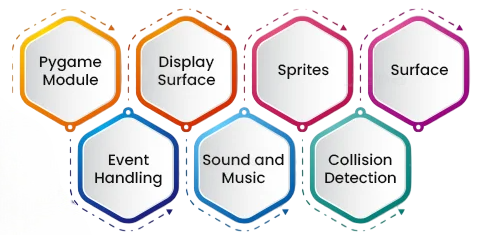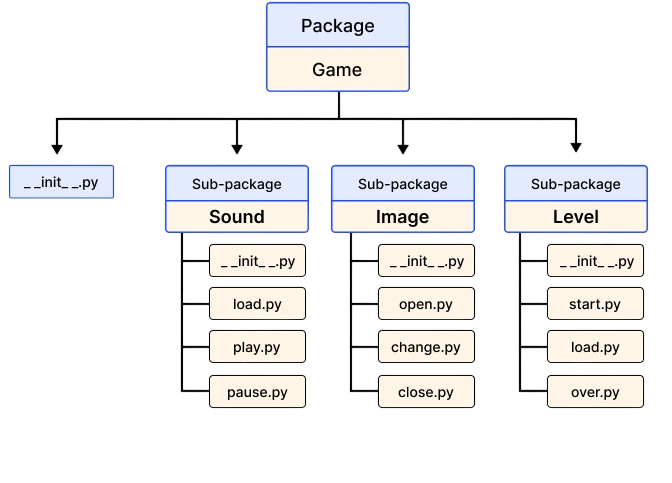
- Introduction to Pygame
- Setting Up Pygame
- Project 1: Snake Game
- Project 2: Space Invaders
- Project 3: Car Racing Game
- Project 4: Pong Game
- Project 5: Flappy Bird Clone
- Project 6: Brick Breaker
- Project 7: Platformer Game
- Project 8: Chess Game
- Final Thoughts and Next Steps
Introduction to Pygame
Pygame is a popular Python library designed for developing video games and pygame projects in multimedia applications. Built on top of the Simple DirectMedia Layer (SDL), Pygame provides an easy interface for handling graphics, sound, and user input. It is widely used by beginners because it’s simple to set up and does not require advanced programming knowledge to start creating interactive games.

To build on this foundation and unlock deeper capabilities, exploring Python Training reveals how structured learning empowers developers to master game loops, event handling, and object-oriented design transforming basic prototypes into polished, playable experiences. Additionally, Pygame runs on multiple platforms, including Windows, macOS, and Linux, making it accessible to a wide audience. Its active community and abundance of tutorials make it an excellent choice for learning game development concepts, such as sprites, event handling, and collision detection, while building fun and interactive projects.
Interested in Obtaining Your Python Certificate? View The Python Developer Course Offered By ACTE Right Now!
Setting Up Pygame
Before you can start building Pygame projects, you need to set up your environment. Pygame can be installed using Python’s package manager, pip, with a simple command: pip install pygame. Once installed, you can verify it by running a short script that initializes Pygame and opens a simple window.

Setting up also involves ensuring you have the latest version of Python installed. Many developers prefer using an IDE such as PyCharm, VS Code, or Thonny for writing and testing code. To choose the right toolchain for your goals, exploring Scala vs Python reveals how both languages differ in syntax, performance, and use cases helping developers decide between Python’s simplicity and Scala’s functional power for data science, backend systems, or scalable applications. It’s also helpful to create a dedicated project folder for each game to keep assets like images, sounds, and fonts organized.
Project 1: Snake Game
- The Snake Game is a classic beginner project and an ideal way to learn the basics of Pygame. In this game, the player controls a snake that moves around the screen, eating food to grow longer. The challenge lies in avoiding collisions with the walls or the snake’s own body.
- This project teaches core concepts such as updating game states, detecting collisions, and rendering graphics in real time. The snake can be implemented using a list of coordinates representing each segment, while movement is handled by updating these positions in a loop.
- To build on these fundamentals and choose the right tools for future projects, exploring Best Programming Languages to Learn reveals how Python, JavaScript, and Java each offer unique strengths for game development, data science, and scalable application design.
- You also learn about event handling to control the snake’s direction using keyboard inputs. The Snake Game offers room for improvement by adding features such as a scoring system, increasing speed as the game progresses, or implementing different difficulty levels.
- Space Invaders is another retro game where the player controls a spaceship at the bottom of the screen, shooting enemies descending from the top. This project introduces you to sprite handling in Pygame, where each enemy and the player’s ship is represented as an image with movement patterns. The game loop continuously updates the positions of enemies and bullets, checks for collisions, and redraws the screen.
- You can also implement sound effects for shooting and explosions, which enhances the gameplay experience. By creating this game, you learn about handling multiple objects on the screen, managing projectile movement, and creating enemy patterns. Adding difficulty scaling, power-ups, and high-score tracking can make the project more engaging.
- The Flappy Bird Clone is a fun project that introduces you to procedural obstacle generation and gravity simulation. In this game, the player controls a bird that must navigate through gaps between moving pipes. The main challenge is managing the bird’s vertical movement with gravity pulling it down and user input causing it to flap upward.
- The pipes continuously move from right to left, and new ones are generated randomly to keep the gameplay unpredictable. You also learn how to handle scrolling backgrounds and keep track of scores. The Flappy Bird Clone project is an excellent way to understand how to create endless runner-style games and manage game physics smoothly.
- Brick Breaker involves controlling a paddle at the bottom of the screen to bounce a ball upward and break bricks arranged at the top. This project combines collision detection with object destruction, as bricks disappear when hit by the ball. You can implement multiple brick layouts, power-ups like extra balls or paddle size changes.
- This game introduces you to trajectory changes based on collision points, which is crucial in simulating realistic ball movement. To translate such physics-based logic into scalable applications, exploring Java Programming reveals how object-oriented principles, event-driven design.
- Robust libraries empower developers to build interactive games, simulations, and enterprise-grade software with precision and control. It also reinforces the importance of smooth paddle control and managing multiple moving objects within the same game loop.
- A Chess Game in Pygame focuses on turn-based gameplay and logic rather than fast-paced action. This project teaches you how to represent a chessboard and pieces, implement movement rules for each piece, and detect valid moves and check/checkmate conditions.
- You learn about mouse click event handling to select and move pieces, as well as visual highlights for possible moves. For a more advanced version, you can implement a simple AI opponent or allow for network-based multiplayer.
- Chess in Pygame also highlights the importance of separating game logic from rendering, ensuring that rules are handled correctly regardless of how the visuals are updated.
Gain Your Master’s Certification in Python Developer by Enrolling in Our Python Master Program Training Course Now!
Project 2: Space Invaders
Project 3: Car Racing Game
A Car Racing Game in Pygame typically involves controlling a car that moves left or right to avoid obstacles on the road. This project focuses on continuous background movement, giving the illusion of speed, and obstacle generation that challenges the player’s reflexes. You learn how to implement smooth movement controls, detect collisions between the car and obstacles, and manage increasing difficulty levels as the game progresses. To master these mechanics and scale your skills across real-world applications, exploring Python Training reveals how structured learning empowers developers to build interactive games, automate logic, and apply object-oriented principles with precision. You can also include multiple lanes, varying obstacle sizes, and special items that give the player temporary abilities, such as invincibility. The project demonstrates the importance of frame rate control to ensure smooth gameplay and teaches you how to manage game speed effectively.
Are You Preparing for Python Jobs? Check Out ACTE’s Python Interview Questions and Answers to Boost Your Preparation!
Project 4: Pong Game
The Pong Game is one of the simplest and most iconic games, making it a great starting point for Pygame beginners. In Pong, two paddles hit a ball back and forth, and the player scores when the opponent fails to return the ball. This project teaches you how to handle basic physics in games, such as ball movement and bounce angles when hitting paddles or walls. To expand these foundational skills into full-scale development, exploring How to Become a Full Stack Developer reveals how mastering both frontend and backend technologies empowers you to build complete applications from interactive interfaces to robust server logic and database integration. It also introduces AI concepts if you create a single-player mode where the second paddle is controlled by the computer. You can implement scoring, speed variation, and even multiplayer functionality.
Project 5: Flappy Bird Clone
Project 6: Brick Breaker
Project 7: Platformer Game
A Platformer Game, similar to Mario, is a more complex Pygame project involving player movement, jumping mechanics, and level design. The player navigates platforms, avoids obstacles, and possibly defeats enemies while collecting items. This project teaches you how to implement gravity, collision detection with platforms, and scrolling levels as the player moves. To understand how such game logic fits into broader development roles, exploring Full Stack vs Front End vs Back End reveals how each layer contributes from visual rendering and user interaction to physics engines and server-side data handling. You also learn about tile-based map creation, where each part of the environment is represented by a tile image. Platformers are excellent for experimenting with animations, character states (idle, walking, jumping), and interactive objects like trampolines or moving platforms. You can extend this project by adding multiple levels, boss fights, and storyline elements.
Project 8: Chess Game
Final Thoughts and Next Steps
Pygame is an excellent framework for learning game development fundamentals, and the projects discussed above provide a solid foundation for understanding graphics rendering, event handling, and game logic. Starting with simple games like Snake or Pong allows you to grasp the basics, while more advanced projects like Platformers or Chess challenge you to implement complex mechanics and logic. To scale your skills from beginner prototypes to sophisticated gameplay systems, exploring Python Training reveals how structured learning equips developers to master game loops, collision detection, AI behavior, and modular design using Python’s versatile libraries. Once you’re comfortable with Pygame, you might explore other Python game frameworks or even move to more advanced engines like Unity or Godot, which offer more features for 2D and 3D games.





